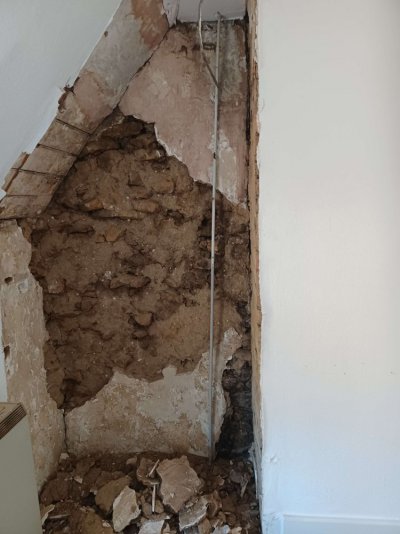WillC
Member
- Messages
- 1
- Location
- Oxfordshire
So I am very new to owning a period house (owning a house full stop!) and I've sort of dug myself into a hole and need some advice on what to do next.
The house that I've just bought is a stone cottage, probably late 18th or early 19th century (not quite sure, finding out how old it actually is is on the list of 'fun jobs'). In doing some decorating (the house had been a rental property and has been liberally covered in woodchip and latext paint), I've stripped back one corner of the bedroom to find that the plaster behind was cracked and coming away. On taking this back, there appears to be a layer of white plaster (patched with pink plaster), over what appears to be an original plaster or render. This appears to have almost entirely failed - it has the consistency of dried mud, crumbling to the touch and coming away in great chunks, going back to the stone behind. There are odd white lumps of what appear to be salt in it, also. This is how it appears, after I've had a crack at removing it:

There is a lot of material coming away because it seems like the builders have tried to even the wall out to the level of the proudest stones, which are a good 2 - 3 inches or so out from the general line of the wall. There are lots of bits of old quarry tile that appear to have been used to build up the right level.
My current working theory (based on a small amount of Googling) is that in the past smoke from the fireplace has leaked into the wall (in the bottom-right, where the plaster has been discoloured and carbonised), which I have read can cause problems with plaster, though I don't really have any experience to know if this is right.
I suppose my question is where to go from here? I had thought I might complete removing as much of the old plaster/render as possible (right down to the stone), and apply a premixed lime plaster, perhaps leaving some of the prouder stones visible (this would match other areas of the house where the stonework has been exposed). Does this seem like a good approach? I'd be grateful for any advice or insight you could share.
The house that I've just bought is a stone cottage, probably late 18th or early 19th century (not quite sure, finding out how old it actually is is on the list of 'fun jobs'). In doing some decorating (the house had been a rental property and has been liberally covered in woodchip and latext paint), I've stripped back one corner of the bedroom to find that the plaster behind was cracked and coming away. On taking this back, there appears to be a layer of white plaster (patched with pink plaster), over what appears to be an original plaster or render. This appears to have almost entirely failed - it has the consistency of dried mud, crumbling to the touch and coming away in great chunks, going back to the stone behind. There are odd white lumps of what appear to be salt in it, also. This is how it appears, after I've had a crack at removing it:

There is a lot of material coming away because it seems like the builders have tried to even the wall out to the level of the proudest stones, which are a good 2 - 3 inches or so out from the general line of the wall. There are lots of bits of old quarry tile that appear to have been used to build up the right level.
My current working theory (based on a small amount of Googling) is that in the past smoke from the fireplace has leaked into the wall (in the bottom-right, where the plaster has been discoloured and carbonised), which I have read can cause problems with plaster, though I don't really have any experience to know if this is right.
I suppose my question is where to go from here? I had thought I might complete removing as much of the old plaster/render as possible (right down to the stone), and apply a premixed lime plaster, perhaps leaving some of the prouder stones visible (this would match other areas of the house where the stonework has been exposed). Does this seem like a good approach? I'd be grateful for any advice or insight you could share.
